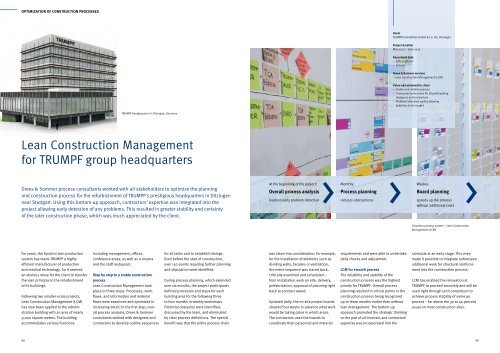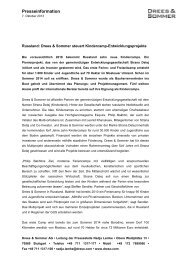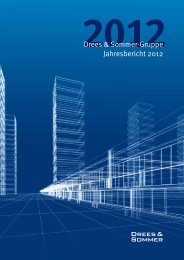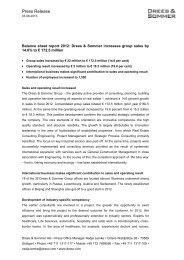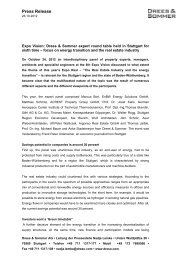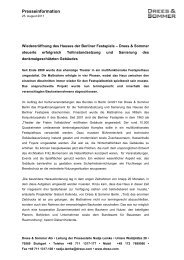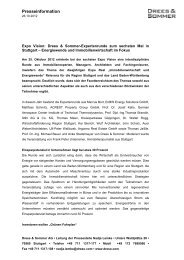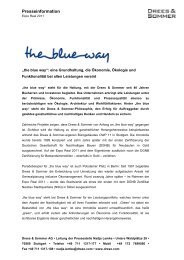Download Annual Report 2012 - Drees & Sommer
Download Annual Report 2012 - Drees & Sommer
Download Annual Report 2012 - Drees & Sommer
Create successful ePaper yourself
Turn your PDF publications into a flip-book with our unique Google optimized e-Paper software.
OPTIMIZATION OF CONSTRUCTION PROCESSES<br />
Client<br />
TRUMPF Immobilien GmbH & Co. KG, Ditzingen<br />
Project duration<br />
May <strong>2012</strong> – June 2013<br />
Key project data<br />
– GFA: 8,980 m 2<br />
– 8 levels<br />
<strong>Drees</strong> & <strong>Sommer</strong> services<br />
– Lean Construction Management (LCM)<br />
Value-add achieved for client<br />
– Stable and reliable process<br />
– Transparent processes for all participating<br />
designers and contractors<br />
– Problems detected earlier allowing<br />
solutions to be sought<br />
TRUMPF headquarters in Ditzingen, Germany<br />
Lean Construction Management<br />
for TRUMPF group headquarters<br />
> ><br />
><br />
At the beginning of the project:<br />
Monthly:<br />
Weekly:<br />
<strong>Drees</strong> & <strong>Sommer</strong> process consultants worked with all stakeholders to optimize the planning<br />
Overall process analysis Process planning<br />
Board planning<br />
and construction process for the refurbishment of TRUMPF‘s prestigious headquarters in Ditzingen<br />
leads to early problem detection<br />
reduces obstructions<br />
speeds up the process<br />
near Stuttgart. Using this bottom-up approach, contractors‘ expertise was integrated into the<br />
without additional costs<br />
project allowing early detection of any problems. This resulted in greater stability and certainty<br />
of the later construction phase, which was much appreciated by the client.<br />
Seamless process system – Lean Construction<br />
Management (LCM)<br />
For years, the Synchro lean production<br />
system has made TRUMPF a highly<br />
efficient manufacturer of production<br />
and medical technology. So it seemed<br />
an obvious move for the client to transfer<br />
the lean principle to the refurbishment<br />
of its buildings.<br />
Following two smaller-scale projects,<br />
Lean Construction Management (LCM)<br />
has now been applied to the administration<br />
building with an area of nearly<br />
9,000 square meters. The building<br />
accommodates various functions<br />
including management, offices,<br />
conference areas, as well as a cinema<br />
and the staff restaurant.<br />
Step by step to a stable construction<br />
process<br />
Lean Construction Management took<br />
place in three steps. Processes, workflows,<br />
and information and material<br />
flows were examined and optimized in<br />
increasing detail. In the first step, overall<br />
process analysis, <strong>Drees</strong> & <strong>Sommer</strong><br />
consultants worked with designers and<br />
contractors to develop outline sequences<br />
for all tasks and to establish timings.<br />
Even before the start of construction,<br />
over 150 points requiring further planning<br />
and stipulation were identified.<br />
During process planning, which extended<br />
over six months, the project participants<br />
defined processes and steps for each<br />
building area for the following three<br />
to four months in weekly workshops.<br />
Potential obstacles were identified,<br />
discussed by the team, and eliminated<br />
by clear process definitions. The special<br />
benefit was that the entire process chain<br />
was taken into consideration: For example,<br />
for the installation of elements such as<br />
dividing walls, facades or ventilation,<br />
the entire sequence was traced back,<br />
critically examined and scheduled –<br />
from installation work on site, delivery,<br />
prefabrication, approval of planning right<br />
back to contract award.<br />
Updated daily, the on-site project boards<br />
showed four weeks in advance what work<br />
would be taking place in which areas.<br />
The contractors used the boards to<br />
coordinate their personnel and material<br />
requirements and were able to undertake<br />
daily checks and adjustment.<br />
LCM for smooth process<br />
The reliability and stability of the<br />
construction process was the highest<br />
priority for TRUMPF. Overall process<br />
planning resulted in critical points in the<br />
construction process being recognized<br />
up to three months earlier than without<br />
lean management. The bottom-up<br />
approach promoted the strategic thinking<br />
on the part of all involved, and contractors‘<br />
expertise was incorporated into the<br />
schedule at an early stage. This even<br />
made it possible to integrate unforeseen<br />
additional work for structural reinforcement<br />
into the construction process.<br />
LCM has enabled the renovation at<br />
TRUMPF to proceed smoothly and will be<br />
used right through until completion to<br />
achieve process stability of some 90<br />
percent – far above the 30 to 40 percent<br />
usual on most construction sites.<br />
88<br />
89


